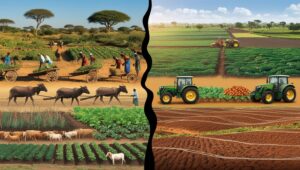Our Social Media Handles
Western Scientific Agricultural Techniques in Rural Africa: A Barrier to Growing Indigenous Capacity for Sustainable Agriculture

According to the Independent Theory of the Origin of Agriculture, agriculture as an activity developed independently throughout the world as dictated by local conditions. The local conditions that determine the type of agriculture practiced in any part of the world depend on climate, availability of labor, and other factors.
Several local conditions in Europe and the United States promoted radical changes in agricultural methods. Agriculture was transformed from a simple occupation to a complex and highly professional practice, where farmers started using improved cultivation methods. This was driven by a significant demand for food by the rapidly growing urban population and an even greater demand for agricultural raw materials for the many modern and improved textile and leather factories.
For many years, African societies used local agricultural techniques to meet their demands and needs. These demands were met directly from the land they cultivated and the animals they kept. Thus, crop farming and animal rearing were seen as the main economic activities, encouraging large families as many workers were needed. Everyone had a job, making the family the main source of production.
Today, the Western scientific approach to agriculture is widely applied without considering local strategies. Studies aimed at creating a logical link between existing local problems and this approach are not undertaken. Consequently, we end up following the footsteps of the Western scientific community without complementary local strategies to solve local agricultural problems.
Research has revealed that the agricultural sector in most African countries employs capital-intensive techniques rather than labor-intensive ones, reducing human labor as they become more mechanized. It has also been noted that complex agricultural technology, which is expensive and unnecessary at a given stage, is being deployed. It has been shown that if simpler technology, such as animal-drawn carts instead of tractors, were used, farmers would save significantly and more jobs would be created.
Scholars using dependency theory to explain a country’s economic policy criticize the diffusion of irrelevant and sometimes obsolete technology, which is capital-intensive rather than labor-intensive and poses environmental hazards. If modern and traditional farming methods are used together, they can potentially improve agriculture and serve as criteria for environmental management by increasing production output and conserving biodiversity sustainably. However, Western scientific knowledge and African traditional knowledge of farming are seen as two competing knowledge systems.
In such debates, I side with African traditional knowledge as the better option. While I do not dismiss the output focus of science, I highlight the failure of conventional agricultural practices to be effectively and equitably applied to different parts of the world where agriculture is practiced. Ordinarily, scientific agricultural practices are not environmentally sound and ecologically viable. On the other hand, local traditional farming methods play a significant role in sustainable agriculture development. These methods empower local people through their participation in development programs, are resilient and beneficial to farmers regardless of income level by reducing production costs, are adaptable in different environmental and economic contexts, and require fewer economic resources.
I will explain what research has established as the traditional knowledge and strategies that should be preserved to ensure the survival of traditional societies and promote environmental conservation. This includes cultivation methods and soil conservation structures such as zero tillage, the pit system, indigenous agroforestry, and traditional agro-silvopastoral systems. The following is a simple explanation of how they are applied:
- Zero Tillage: Involves digging holes where seeds are planted, leaving other areas intact. This conserves soil structure and fertility while reducing soil erosion.
- Pit System: Mostly effective in mountainous areas, it involves using pits with green manuring, crop rotation, and fallowing to maintain soil fertility.
- Indigenous Agroforestry: Involves planting multipurpose trees and shrubs together with crops and rearing animals simultaneously. This promotes soil conservation, nutrient efficiency, and income for farmers.
- Traditional Agro-Silvopastoral System: Associated with livestock production carried out alongside subsistence crop rotation. This system maintains soil fertility, reduces erosion, and provides food, fuel, and income for farmers.
Local traditional farming methods are environmentally sound and ecologically viable. This knowledge and its application should be taken seriously. Today, there is a wealth of information demonstrating the existence of traditional strategies for ensuring sustainable use of agricultural resources and improving agricultural outputs at a lower cost.
Considering the impact of Western scientific techniques on climate, employment, income, and health, we must be conscious of the threats they pose to our agriculture. For example, we clear our multipurpose traditional trees and shrubs, leading to biodiversity loss; we fill our fresh air with agricultural-related chemical gases, creating dangerous microclimate effects; we use excessive inorganic fertilizers beyond optimum levels, destabilizing our soil organisms; and we plant exotic trees that deplete our land of water and nutrients.
For sustainable agriculture, we need a self-reliant approach that solves most of our problems. Dr. AlShariat, in his book “Where Shall We Begin,” stated that a freethinker in one place cannot be effective in another area. To him, a freethinker is someone who comes from a particular society, understands the problems affecting his people, and can lead them to the right destination. Based on this reasoning, Western scientific techniques cannot fully solve our problems. We need local freethinkers with a strong will and sustained long-term commitment to meaningfully encourage and grow indigenous capacity rather than copying Western capital and technology, which threaten local strategies that could reduce the negative effects of agriculture.

